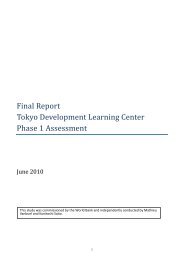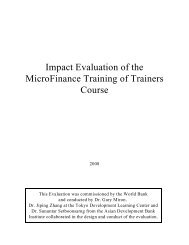5th Generation Distance Education - Tokyo Development Learning ...
5th Generation Distance Education - Tokyo Development Learning ...
5th Generation Distance Education - Tokyo Development Learning ...
Create successful ePaper yourself
Turn your PDF publications into a flip-book with our unique Google optimized e-Paper software.
5 th <strong>Generation</strong> <strong>Distance</strong> <strong>Education</strong> :<br />
A Sustainable Approach to <strong>Development</strong><br />
Professor J C Taylor<br />
Deputy Vice Chancellor (Global <strong>Learning</strong> Services)<br />
University of Southern Queensland<br />
Australia
Future Projections<br />
The World Bank expects the number<br />
of higher education students will<br />
more than double from 70 million to<br />
160 million by 2025<br />
(Source: Richard Gluyas, New Nabs e-School Deal<br />
http://finance.news.com.au, 22 April 2000).
Leadership Challenge<br />
The fact that the present traditional<br />
approaches based on conventional<br />
classroom-based teaching and learning<br />
will not be capable of meeting the<br />
escalating demand for higher education<br />
and professional development presents a<br />
real leadership challenge
Cost-Effective Access<br />
In both developed and developing<br />
countries, the Internet will provide the<br />
only viable cost-effective conduit to<br />
provide access to ongoing<br />
opportunities for education and<br />
training
Five <strong>Generation</strong>s of <strong>Distance</strong><br />
<strong>Education</strong> Technology<br />
• The Correspondence Model<br />
• The Multimedia Model<br />
• The Telelearning Model<br />
• The Flexible <strong>Learning</strong> Model<br />
• The Intelligent Flexible <strong>Learning</strong> Model
First <strong>Generation</strong> (Asynchronous)<br />
MODELS OF<br />
DISTANCE EDUCATION<br />
AND ASSOCIATED<br />
DELIVERY TECHNOLOGIES<br />
CHARACTERISTICS OF DELIVERY TECHNOLOGIES<br />
Time<br />
FLEXIBILITY<br />
Place<br />
Pace<br />
HIGHLY<br />
REFINED<br />
MATERIALS<br />
ADVANCED<br />
INTERACTIVE<br />
DELIVERY<br />
INSTITUTIONAL<br />
VARIABLE<br />
COSTS<br />
APPROACHING<br />
ZERO<br />
THE CORRESPONDENCE<br />
MODEL<br />
• Print<br />
Yes Yes Yes Yes No<br />
No
Second <strong>Generation</strong> (Asynchronous)<br />
MODELS OF<br />
DISTANCE EDUCATION<br />
AND ASSOCIATED<br />
DELIVERY TECHNOLOGIES<br />
CHARACTERISTICS OF DELIVERY TECHNOLOGIES<br />
Time<br />
FLEXIBILITY<br />
Place<br />
Pace<br />
HIGHLY<br />
REFINED<br />
MATERIALS<br />
ADVANCED<br />
INTERACTIVE<br />
DELIVERY<br />
INSTITUTIONAL<br />
VARIABLE<br />
COSTS<br />
APPROACHING<br />
ZERO<br />
THE MULTIMEDIA MODEL<br />
• Print<br />
• Audiotape<br />
• Videotape<br />
• Computer-based learning<br />
(eg CML/CAL)<br />
• Interactive video<br />
Yes Yes Yes Yes No<br />
Yes Yes Yes Yes No<br />
Yes Yes Yes Yes No<br />
Yes Yes Yes Yes Yes<br />
Yes Yes Yes Yes Yes<br />
No<br />
No<br />
No<br />
No<br />
No
Variable costs tend to increase or<br />
decrease directly (often linearly) with<br />
fluctuations in the volume of activity.<br />
In traditional distance education delivery, the<br />
distribution of packages of self-instructional<br />
materials (printed study guides, audiotapes,<br />
videotapes, etc) is a variable cost, which<br />
varies in direct proportion to the number of<br />
students enrolled.
Third <strong>Generation</strong> (Synchronous)<br />
MODELS OF<br />
DISTANCE EDUCATION<br />
AND ASSOCIATED<br />
DELIVERY TECHNOLOGIES<br />
CHARACTERISTICS OF DELIVERY TECHNOLOGIES<br />
Time<br />
FLEXIBILITY<br />
Place<br />
Pace<br />
HIGHLY<br />
REFINED<br />
MATERIALS<br />
ADVANCED<br />
INTERACTIVE<br />
DELIVERY<br />
INSTITUTIONAL<br />
VARIABLE<br />
COSTS<br />
APPROACHING<br />
ZERO<br />
THE TELELEARNING MODEL<br />
• Audio-teleconferencing<br />
No<br />
No<br />
No<br />
No<br />
Yes<br />
No<br />
• Audiographic communication<br />
• Videoconferencing<br />
• Access Grid<br />
No<br />
No<br />
No<br />
No<br />
No<br />
No<br />
No<br />
No<br />
No<br />
Yes<br />
?<br />
?<br />
Yes<br />
Yes<br />
Yes<br />
No<br />
No<br />
No<br />
• Broadcast TV/Radio and<br />
Audio-teleconferencing<br />
No<br />
No<br />
No<br />
Yes<br />
Yes<br />
No<br />
• Webcasting (live)<br />
No<br />
No<br />
No<br />
?<br />
No<br />
Yes
Fourth <strong>Generation</strong> (Asynchronous)<br />
MODELS OF<br />
DISTANCE EDUCATION<br />
AND ASSOCIATED<br />
DELIVERY TECHNOLOGIES<br />
CHARACTERISTICS OF DELIVERY TECHNOLOGIES<br />
Time<br />
FLEXIBILITY<br />
Place<br />
Pace<br />
HIGHLY<br />
REFINED<br />
MATERIALS<br />
ADVANCED<br />
INTERACTIVE<br />
DELIVERY<br />
INSTITUTIONAL<br />
VARIABLE<br />
COSTS<br />
APPROACHING<br />
ZERO<br />
THE FLEXIBLE LEARNING MODEL<br />
• Interactive multimedia (IMM)<br />
• Internet-based access to<br />
WWW learning resources<br />
• Computer mediated<br />
communication (CMC)<br />
• Audio on demand<br />
• Video on demand<br />
Yes Yes Yes Yes Yes<br />
Yes Yes Yes Yes Yes<br />
Yes Yes Yes Yes Yes<br />
Yes<br />
Yes<br />
No<br />
Yes Yes Yes Yes No Yes<br />
Yes Yes Yes Yes No Yes
Fifth <strong>Generation</strong> (Asynchronous)<br />
MODELS OF<br />
DISTANCE EDUCATION<br />
AND ASSOCIATED<br />
DELIVERY TECHNOLOGIES<br />
CHARACTERISTICS OF DELIVERY TECHNOLOGIES<br />
Time<br />
FLEXIBILITY<br />
Place<br />
Pace<br />
HIGHLY<br />
REFINED<br />
MATERIALS<br />
ADVANCED<br />
INTERACTIVE<br />
DELIVERY<br />
INSTITUTIONAL<br />
VARIABLE<br />
COSTS<br />
APPROACHING<br />
ZERO<br />
THE INTELLIGENT FLEXIBLE<br />
LEARNING MODEL<br />
• Interactive multimedia<br />
• Internet-based access to<br />
WWW learning resources<br />
• CMC using automated<br />
response systems<br />
• Campus portal access to<br />
institutional processes &<br />
LMS activities<br />
Yes Yes Yes Yes Yes<br />
Yes Yes Yes Yes Yes<br />
Yes Yes Yes Yes Yes<br />
Yes Yes Yes Yes Yes<br />
Yes<br />
Yes<br />
Yes<br />
Yes
GDLN Futures<br />
To meet the demand for education and<br />
training in the knowledge society:<br />
GDLN needs to capitalize on its<br />
investment in ICT infrastructure and<br />
synchronous activities, and expand its<br />
commitment to blended and especially<br />
asynchronous approaches
Digital Repository Project<br />
• Focussing on Repository Infrastructure<br />
• Supporting the Australian contribution to the e-<br />
Framework for <strong>Education</strong> and Research<br />
• Partners – USQ, UNE, USC, Newcastle, Massey<br />
• DEST funding of $6.4million for RUBRIC and<br />
related extension projects.<br />
Regional Universities Building Research<br />
Infrastructure Collaboratively (RUBRIC)
Managing the fixed costs of courseware design and development<br />
ICE (Integrated Content Environment)<br />
RENDITIONS:<br />
Print<br />
Web<br />
CD<br />
DVD<br />
ICE:<br />
OPEN SOURCE<br />
SOFTWARE<br />
XML based ICE application<br />
CONTENT<br />
REPOSITORY:<br />
User’s<br />
“working copy”<br />
Version Controlled<br />
Central Repository<br />
INPUT:<br />
Word processsor<br />
(Microsoft Word or OpenOffice.org)<br />
USQ’s Open Source e-Publishing System
The Goals of the OCW Consortium<br />
• Extend the reach and impact of open<br />
courseware around the world<br />
• Foster the development of additional<br />
open courseware projects<br />
• Ensure the long-term sustainability of<br />
open courseware projects by<br />
identifying ways to improve<br />
effectiveness and reduce costs
Managing the Variable Costs of<br />
Student Administrative Support<br />
Ask a<br />
question/<br />
send an<br />
email<br />
NO<br />
Incoming<br />
“new”<br />
admin<br />
question<br />
from<br />
student<br />
Search / Match<br />
“Immediate”<br />
admin<br />
feedback to<br />
student<br />
USQAssist<br />
Assist:<br />
Self-service Q & A<br />
Repository<br />
Previous Questions<br />
Previous Answers<br />
Trigger<br />
YES<br />
USQ staff<br />
member –<br />
“New<br />
Answer”
Web Self-Service<br />
Knowledge Base<br />
• 2002: 48,983 student visits<br />
• 2003: 209,926 student visits<br />
• 2004: 299,900 student visits<br />
• 2005: 441,459 student visits<br />
• 2006: 624,244 student visits
Managing the Variable<br />
Costs of Customer Contacts<br />
Face-to-face contact US $8.00<br />
Phone contact (average) US $4.00 - $6.00<br />
Email US $0.50 - $2.50<br />
Web Self-Service US $0.24<br />
Source: Gartner Group Inc.
USQAssist<br />
During 2006, USQAssist<br />
processed 624,244 student visits<br />
at an approx. cost of $149,819,<br />
compared to an estimated<br />
equivalent phone enquiry cost of<br />
approx. $3.12 million.
Managing the Variable Costs of Academic Support<br />
Metadata<br />
Schema Model<br />
NO<br />
Duty Tutor<br />
Incoming<br />
“new”<br />
academic<br />
question<br />
from<br />
student<br />
Search / Match<br />
Reusable <strong>Learning</strong><br />
Objects<br />
Academic Content<br />
Repository<br />
Previous Questions<br />
<br />
Previous Answers<br />
<br />
New Answer<br />
“Immediate”<br />
academic<br />
feedback to<br />
student<br />
Trigger<br />
YES
Managing the Variable Costs of Academic Support<br />
NO<br />
Duty Tutor<br />
Incoming<br />
“new”<br />
academic<br />
question<br />
from<br />
student<br />
Search / Match<br />
Reusable <strong>Learning</strong><br />
Objects<br />
Academic Content<br />
Repository<br />
Previous Questions<br />
<br />
Previous Answers<br />
<br />
New Answer<br />
“Immediate”<br />
academic<br />
feedback to<br />
student<br />
Trigger<br />
YES
• USQ has registered the relevant<br />
internet domain names for<br />
Academic Volunteers International<br />
• USQ intends to develop an<br />
extensible web architecture and<br />
associated software as an open<br />
source initiative
5 th <strong>Generation</strong><br />
As the intelligent databases and<br />
academic volunteer initiatives<br />
become more comprehensive,<br />
the institutional variable costs for<br />
the provision of effective student<br />
support will tend towards zero
<strong>5th</strong> <strong>Generation</strong>:<br />
Increasing Access<br />
In effect, fifth generation distance<br />
education will provide students with<br />
quality tuition and effective<br />
pedagogical and administrative<br />
support services at much lower cost
Leadership Challenge<br />
“The single greatest challenge facing<br />
managers in the developed countries<br />
of the world is to increase the<br />
productivity of knowledge and service<br />
workers”<br />
Peter Drucker ( 1991).
The Virtual Revolution?<br />
“Any new technology environment<br />
eventually creates a totally new<br />
human environment”<br />
Marshall McLuhan

















